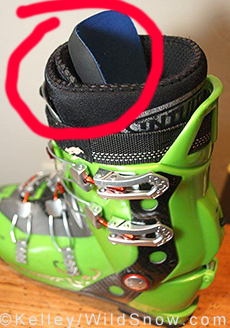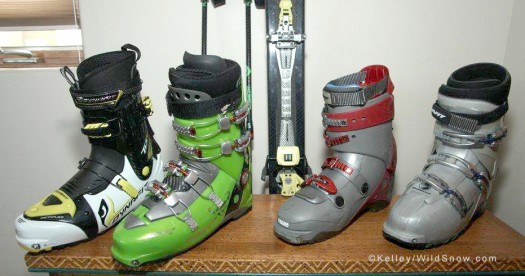I remember when Lou introduced me to lightweight gear. I’ll date both of us and admit that at one time long ago in a far away land we had the old Marker “wishbone” alpine touring bindings, offering an amazing two inch range of motion with return of the boot sole to a flat ski. Heel lifters? They were several years in the future.
So it was a revelation when Lou showed up one day in 1975 with the first heel lift pegs on a Ramer binding that weighed about half of the klunkers the rest of us were on. (The AT binding heel lift was pretty much invented by Ramer, though a few other binding makers in Europe may have been experimenting with similar concepts).
With his Ramers, I saw the young master turn a 4,000 ft. climb to the summit of 13,560 Ski Hayden near Aspen into a 2 hour blitz (fast back then, but now skimo racers do that same vert in half that time). It took the rest of us at least 4 hours of slogging upward to achieve the same result.
Frame bindings such as Ramer, Silvretta and Fritschi were supplanted a decade or so later by innovative Dynafit “tech” gear. It is hard to say which iteration of equipment changed ski mountaineering as we knew it. Ramer showed us that lighter bindings with a climbing heel lift were important; Silvretta and Fritschi improved on the idea. Then Fritz Barthel continued the vision with his still lighter and more functional tech binding. Whatever the case (I’d hand the honors to Fritz), ski mountaineering got the weight and function revolution we’ve been enjoying ever since.
I’ve never been much of an early adopter, but I pay attention! In the 1980’s when Lou early-adopted Dynafit bindings and wrote about them in Couloir Magazine, I noticed.
The question that came up: If the new gear would work for me at 185 pounds and 6’2”, the gains were just too good to ignore. I’d previously been down the path of broken dreams with equipment recommended by others smaller than me, so I was wary as some still are. To my surprise and delight, I’ve found over the past decades that all things Dynafit held up to my weight and the force I exert on alpine ski equipment. Mind you, I’m not dropping cliffs any more, (did I ever, really?), and I treat my gear with respect. But some days I’m still skinning 4,000 vert and difficult snow, so the bindings and boots get used in their intended environment.
Various models of Dynafit boots I’ve used include the old 2 buckle, which morphed into the 3 buckle TLT series. Then came the stout, red and grey Aeros that always were wide for my too narrow 13-A (30.0+ mondo) foot, just skied plain weird and are said to have almost put Dynafit out of business. Things change.
For the past four years I’ve been skiing on the Dynafit ZZero, carbon cuff green machine, which to date have been the best performing and nearly the lightest backcountry ski boot I’ve had. It’s been around for a few years now, but in my opinion the Green Machine is still ground breaking in the performance to weight department.
Most recently I’ve looked hard at the Dynafit line evaluating what if any, would be my next step when it came to new boots. They have amazing offerings we’ve never seen the likes of before. Ripper who wants an alpine clone that tours? No problem – Titan. Skimo racer or just plain weight weenie? TLT-5 or something else in that class. Ultimate combo? Perhaps a Vulcan, Mercury or One. Fan boy or skeptic, you have to admit that company has an amazing line of backcountry capable ski boots.
I guess I’ve never been a “Titan” kind of guy in spite of my size, so for my lighter weight rig I settled on the carbon cuffed TLT-5P, as being the best of both worlds. Be careful when you pick up this boot off the shelf. If you use the kind of force we’re accustomed to for the way we think about weight in ski boots, you’ll probably over perform, and hit yourself in the forehead with the thing. What I learned from my years on the ZZero is, the carbon cuff adds stiffness and exquisite control without the weight penalty of other models/brands. I’m looking forward to the same performance with these new TLT’s 5’s I got from the green machines at an even lighter overall weight. Have played with the entry and exit, which is a bit different, and has a learning curve to it, as does the operation of the top buckles with the couple different closure modes for up/downhill and touring modes.
The other thing I’ve found is the greater control offered by the ZZeros with carbon reinforced cuff, is they make the super lightweight skis actually ski better. How often have I bounced down the “frozen glass” surface wishing my featherweight, wide, soft snow ski performed as well in these conditions like it does in the pow? This design is superior in that regard as it simply transmits more leverage and power to the ski, thus enhancing edge hold.

Zzero with Intuition wrap liner and extra foam filler, only way to go for chicken legs.
A few notes about the heat moldable liners. While Dynafit’s Palau made stock liners are quality, it’s been my experience and other’s that when you have a lower volume foot the liners simply do not have enough thickness for a good mold. Hard to know why that is. Perhaps Dynafit trying for a good shop fit so it’s easier to sell boots off the wall — or perhaps it’s just a European boot culture thing. Whatever the case, I cannot say enough good about Intuition brand boot liners. Ever since I began using these in the mid-nineties, they’ve also done nothing but get better. I have literally never had another blister from uphilling or downhilling.
In terms of improving the stock liners I can say another ¾” to 1″ height at the boot top would be key, as well as simply a few more millimeters thickness so they’ll mold better to skinny feet. Yep, I have a very small tibia and not much lower leg muscle mass. I like all the support, cushioning and filling available (read: padding) at the boot top and elsewhere. One of the best heat moldable solutions for this condition is designed with wrap overlays at the front rather than the tongue setup we see in most ski boot issue. Yes, available from Intuition. Thus, if you have the same lower chicken legs I do, consider a wrap liner as a solution.
A bit about Dynafit bindings: over several decades of use I have had only two of what I consider questionable releases, largely caused by my not paying attention to icing of the boot toe sockets and the small area under the binding toe wings “trigger.” So, be sure to de-ice before you click in for descents, and test your binding fixation before you launch by wriggling, stomping, or otherwise placing some energy into your boot and watching for play in the boot/binding interface. Like all things mechanical, use of backcountry skiing equipment in a severe environment takes awareness and diligence.
(WildSnow guest blogger Peter Kelley took up residence in Aspen back in the 1970s and never left, aside from a brief stint on ski patrol in Utah and a few other life altering occurrences.)
Peter Kelley is a longtime Aspen resident and committed backcountry skier who Lou hung out with quite a bit during what we Aspen orginalists call the “days of wine and roses.” Peter skis and bicycle rides worldwide. As well as selling real estate, he did a stint on ski patrol at Snowbird, Utah.

